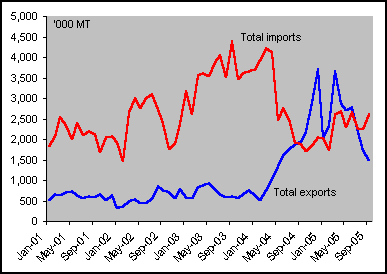|
Overview
The relentless rapid economic development in China is a well-documented story. Nevertheless, what has been less understood, until recently, is the explosive impact of this growth on metal and mineral demand. One such industry that is experiencing the full impact and which has yet to come to grips with the changing landscape is the steel industry. By taking a closer look at the 'China Factor' and its immediate and longer-term impact on the industry, one can better gauge the effect and impact, beneficial or otherwise, on local steel producers and downstream manufacturers.
Part 5 : Impact on Steel Companies in Malaysia
In the last 4 issues, i Capital examined (A) Driver of Production and Consumption and (B) Causes of Raw Material Shortages. Under (B), it reviewed (i) Iron ore, (ii) Coking coal and coke and (iii) Steel scrap. Section (C) focused on the issue of "China - Net Importer or Exporter?".
In studying the impact of the 'China Factor' on the local steel players, it might be worthwhile to first re-visit the present situation that is unfolding globally within the steel industry. In the past, because of the intertwined nature of the industry, steel prices in various regions tend to move in a rather synchronised manner (although at varying price levels) as developments in one region would reverberate and impact trading conditions everywhere else. Historically, the pricing environment in the US would tend to take the lead, due to its role as the largest import market for steel. However, at this juncture, the industry is witnessing an unusual divergence in prices globally, due to the growing influence of China and her still-expanding production capacity.
For example, HRC prices in the US and Canada have seemingly bottomed in late Jul at about US$500 per tonne after peaking in Sep 2004 at US$800 per tonne as disciplined production cut-backs by steel mills combined with rapid inventory depletion by steel centers shortened the down-cycle. With inventory levels back below its long-term average, HRC prices are now on an up-trend, rising to as high as US$600 per tonne, propped up by fresh orders for the reconstruction work after the hurricanes, the re-building of inventories and increased raw material (scrap) surcharges. This is in stark contrast to the situation here in Asia, where after peaking at US$600 per tonne in May, prices have been on a steady decline ever since, falling to as low as below US$400 per tonne in the Chinese spot market. Much of the present weakness is due to concerns regarding the relentless build-up of production capacity by China and to a lesser degree, India and fears of the excess supply flooding the export markets and thus, depressing global prices. On the other hand, as opposed to the two extremes, HRC prices in the EU have generally been pretty flat after falling just below US$500 per tonne from recent highs of US$700 per tonne. So, what does this divergence mean and how will this affect our local manufacturers?
Well, for a start, it is our opinion that this rather unusual scenario may not last long as unless the US erects another trade barrier such as the infamous Section 201, excess steel here in Asia will eventually find their way to the American shores and hence, dampening any further price increases, especially when freight rates have been falling and the US$ appreciating. If this forecast is accurate, what the industry will witness over the next quarter or two is a return to the synchronized fashion where steel prices move in generally the same direction across the globe. As to the direction of the movement over the medium term, much will depend on the strength of the pick-up in demand from North America, the pace of the de-stocking cycle in Europe but more importantly, the discipline of the Chinese mills in slashing production. In this regards, there are encouraging signs.
First, in late Oct, more than 100 members of the China Iron and Steel Association, especially producers of medium and thick steel plates and hot rolled steel sheets, have agreed, despite some resistance from the major producers, to cut planned production in the 4th quarter by more than 5% to stabilise local prices. They have also agreed to price their products on a quarterly basis and increase direct sales to their consumers to ward off volatile price fluctuations in the spot market. Trade figures from China are also lifting the present gloom with monthly steel exports decreasing significantly while imports have been creeping back up (see figure 1).

Figure 1: China's monthly steel exports and imports
Notwithstanding that, average steel prices in the EU have also lately risen by around 8 Euros per tonne, as imports have reduced significantly due to the depreciation of the Euro against the US$. Going forward, steel prices in Asia will likely bottom out by the first or second quarter of 2006, propped up by improved demand from export markets, reduction in cheap imports from India and the former CIS countries and possible hikes in raw material prices (iron ore, coking coal and steel scrap). While we await these developments to take shape, let us take a closer look at the impact of the present down-cycle on some of the local steel manufacturers and their fortunes going forward.
(A) Flat Products Producers
- Ornasteel Holdings
- Lion Corporation
(B) Steel Pipe Makers & Traders
- Engtex Group
- Ann Joo Resources
- Choo Bee Metal Industries
- Hiap Teck Venture
|



